Report: Database Design, Implementation, and Querying for Sweet Shop
VerifiedAdded on 2022/08/30
|22
|4253
|41
Report
AI Summary
This report provides a comprehensive overview of the database design and implementation for an online sweet shop. It begins with an introduction outlining the project's aims and objectives, followed by a class diagram and a discussion of constraints and assumptions. The report delves into design decisions, including the creation of a relational model and the importance of avoiding data redundancy and anomalies. It details the normalization process, progressing through 1NF, 2NF, and 3NF. A relational model is presented, along with a data dictionary. The implementation section includes the actual SQL code for creating tables, defining relationships, and populating the database with data. Finally, the report demonstrates the implementation of queries to meet the database's initial requirements and concludes with a critical evaluation of the design and implementation process. The report covers all the essential aspects of database design, from conceptual modeling to physical implementation, providing a solid foundation for understanding and applying database principles.

Paraphrase This Document
Need a fresh take? Get an instant paraphrase of this document with our AI Paraphraser
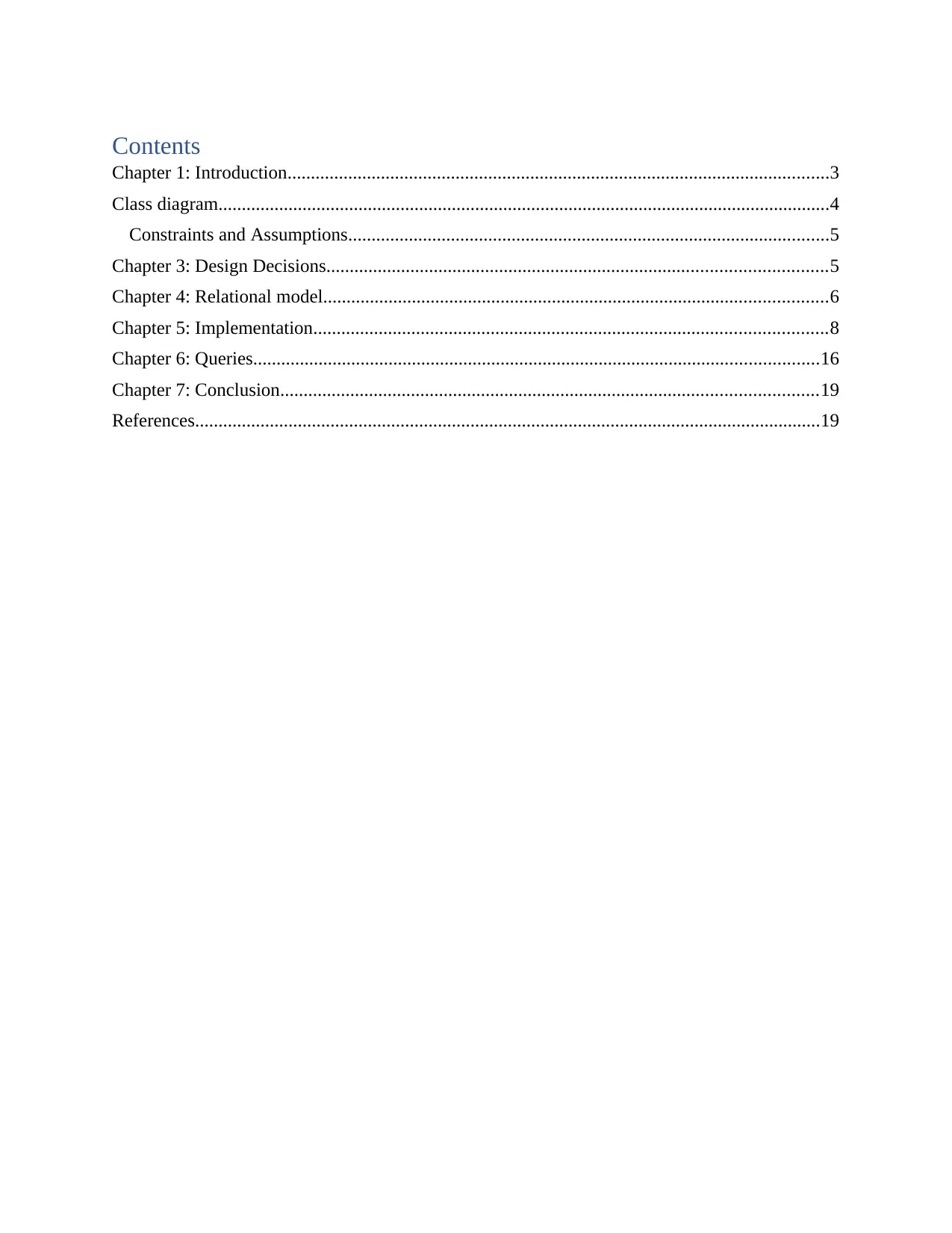
Contents
Chapter 1: Introduction....................................................................................................................3
Class diagram...................................................................................................................................4
Constraints and Assumptions.......................................................................................................5
Chapter 3: Design Decisions...........................................................................................................5
Chapter 4: Relational model............................................................................................................6
Chapter 5: Implementation..............................................................................................................8
Chapter 6: Queries.........................................................................................................................16
Chapter 7: Conclusion...................................................................................................................19
References......................................................................................................................................19
Chapter 1: Introduction....................................................................................................................3
Class diagram...................................................................................................................................4
Constraints and Assumptions.......................................................................................................5
Chapter 3: Design Decisions...........................................................................................................5
Chapter 4: Relational model............................................................................................................6
Chapter 5: Implementation..............................................................................................................8
Chapter 6: Queries.........................................................................................................................16
Chapter 7: Conclusion...................................................................................................................19
References......................................................................................................................................19
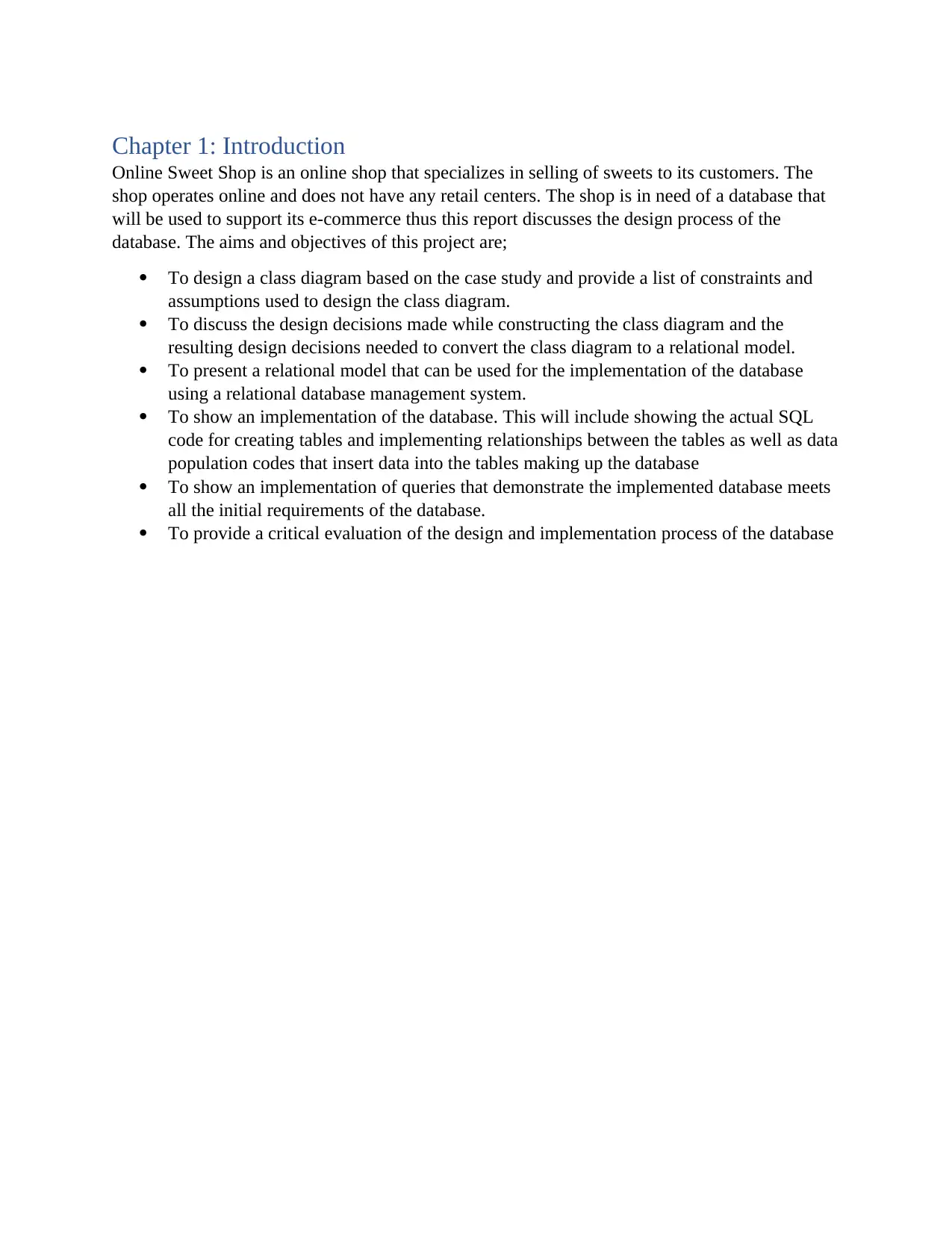
Chapter 1: Introduction
Online Sweet Shop is an online shop that specializes in selling of sweets to its customers. The
shop operates online and does not have any retail centers. The shop is in need of a database that
will be used to support its e-commerce thus this report discusses the design process of the
database. The aims and objectives of this project are;
To design a class diagram based on the case study and provide a list of constraints and
assumptions used to design the class diagram.
To discuss the design decisions made while constructing the class diagram and the
resulting design decisions needed to convert the class diagram to a relational model.
To present a relational model that can be used for the implementation of the database
using a relational database management system.
To show an implementation of the database. This will include showing the actual SQL
code for creating tables and implementing relationships between the tables as well as data
population codes that insert data into the tables making up the database
To show an implementation of queries that demonstrate the implemented database meets
all the initial requirements of the database.
To provide a critical evaluation of the design and implementation process of the database
Online Sweet Shop is an online shop that specializes in selling of sweets to its customers. The
shop operates online and does not have any retail centers. The shop is in need of a database that
will be used to support its e-commerce thus this report discusses the design process of the
database. The aims and objectives of this project are;
To design a class diagram based on the case study and provide a list of constraints and
assumptions used to design the class diagram.
To discuss the design decisions made while constructing the class diagram and the
resulting design decisions needed to convert the class diagram to a relational model.
To present a relational model that can be used for the implementation of the database
using a relational database management system.
To show an implementation of the database. This will include showing the actual SQL
code for creating tables and implementing relationships between the tables as well as data
population codes that insert data into the tables making up the database
To show an implementation of queries that demonstrate the implemented database meets
all the initial requirements of the database.
To provide a critical evaluation of the design and implementation process of the database
⊘ This is a preview!⊘
Do you want full access?
Subscribe today to unlock all pages.

Trusted by 1+ million students worldwide

Class diagram
Figure 1: . . . . . . . . . . . . . . . . . . . . . . . . . . . . . . . . . . . . . . . . . . . . . . . . . . . . . . . . . . . . . . . . . . . . . . . . . . . . . . . .. . . . . . . . . Class
diagram
Figure 1: . . . . . . . . . . . . . . . . . . . . . . . . . . . . . . . . . . . . . . . . . . . . . . . . . . . . . . . . . . . . . . . . . . . . . . . . . . . . . . . .. . . . . . . . . Class
diagram
Paraphrase This Document
Need a fresh take? Get an instant paraphrase of this document with our AI Paraphraser
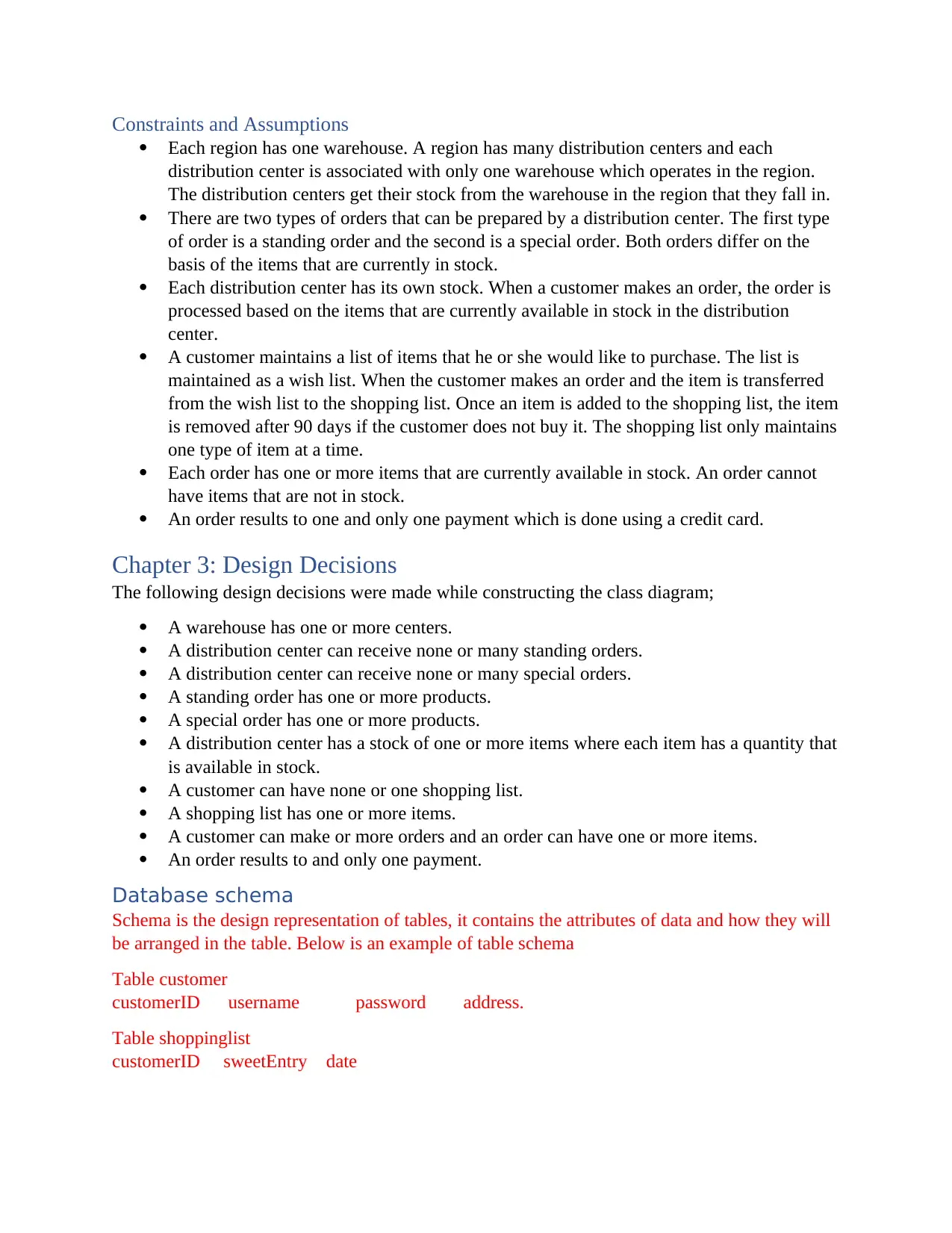
Constraints and Assumptions
Each region has one warehouse. A region has many distribution centers and each
distribution center is associated with only one warehouse which operates in the region.
The distribution centers get their stock from the warehouse in the region that they fall in.
There are two types of orders that can be prepared by a distribution center. The first type
of order is a standing order and the second is a special order. Both orders differ on the
basis of the items that are currently in stock.
Each distribution center has its own stock. When a customer makes an order, the order is
processed based on the items that are currently available in stock in the distribution
center.
A customer maintains a list of items that he or she would like to purchase. The list is
maintained as a wish list. When the customer makes an order and the item is transferred
from the wish list to the shopping list. Once an item is added to the shopping list, the item
is removed after 90 days if the customer does not buy it. The shopping list only maintains
one type of item at a time.
Each order has one or more items that are currently available in stock. An order cannot
have items that are not in stock.
An order results to one and only one payment which is done using a credit card.
Chapter 3: Design Decisions
The following design decisions were made while constructing the class diagram;
A warehouse has one or more centers.
A distribution center can receive none or many standing orders.
A distribution center can receive none or many special orders.
A standing order has one or more products.
A special order has one or more products.
A distribution center has a stock of one or more items where each item has a quantity that
is available in stock.
A customer can have none or one shopping list.
A shopping list has one or more items.
A customer can make or more orders and an order can have one or more items.
An order results to and only one payment.
Database schema
Schema is the design representation of tables, it contains the attributes of data and how they will
be arranged in the table. Below is an example of table schema
Table customer
customerID username password address.
Table shoppinglist
customerID sweetEntry date
Each region has one warehouse. A region has many distribution centers and each
distribution center is associated with only one warehouse which operates in the region.
The distribution centers get their stock from the warehouse in the region that they fall in.
There are two types of orders that can be prepared by a distribution center. The first type
of order is a standing order and the second is a special order. Both orders differ on the
basis of the items that are currently in stock.
Each distribution center has its own stock. When a customer makes an order, the order is
processed based on the items that are currently available in stock in the distribution
center.
A customer maintains a list of items that he or she would like to purchase. The list is
maintained as a wish list. When the customer makes an order and the item is transferred
from the wish list to the shopping list. Once an item is added to the shopping list, the item
is removed after 90 days if the customer does not buy it. The shopping list only maintains
one type of item at a time.
Each order has one or more items that are currently available in stock. An order cannot
have items that are not in stock.
An order results to one and only one payment which is done using a credit card.
Chapter 3: Design Decisions
The following design decisions were made while constructing the class diagram;
A warehouse has one or more centers.
A distribution center can receive none or many standing orders.
A distribution center can receive none or many special orders.
A standing order has one or more products.
A special order has one or more products.
A distribution center has a stock of one or more items where each item has a quantity that
is available in stock.
A customer can have none or one shopping list.
A shopping list has one or more items.
A customer can make or more orders and an order can have one or more items.
An order results to and only one payment.
Database schema
Schema is the design representation of tables, it contains the attributes of data and how they will
be arranged in the table. Below is an example of table schema
Table customer
customerID username password address.
Table shoppinglist
customerID sweetEntry date
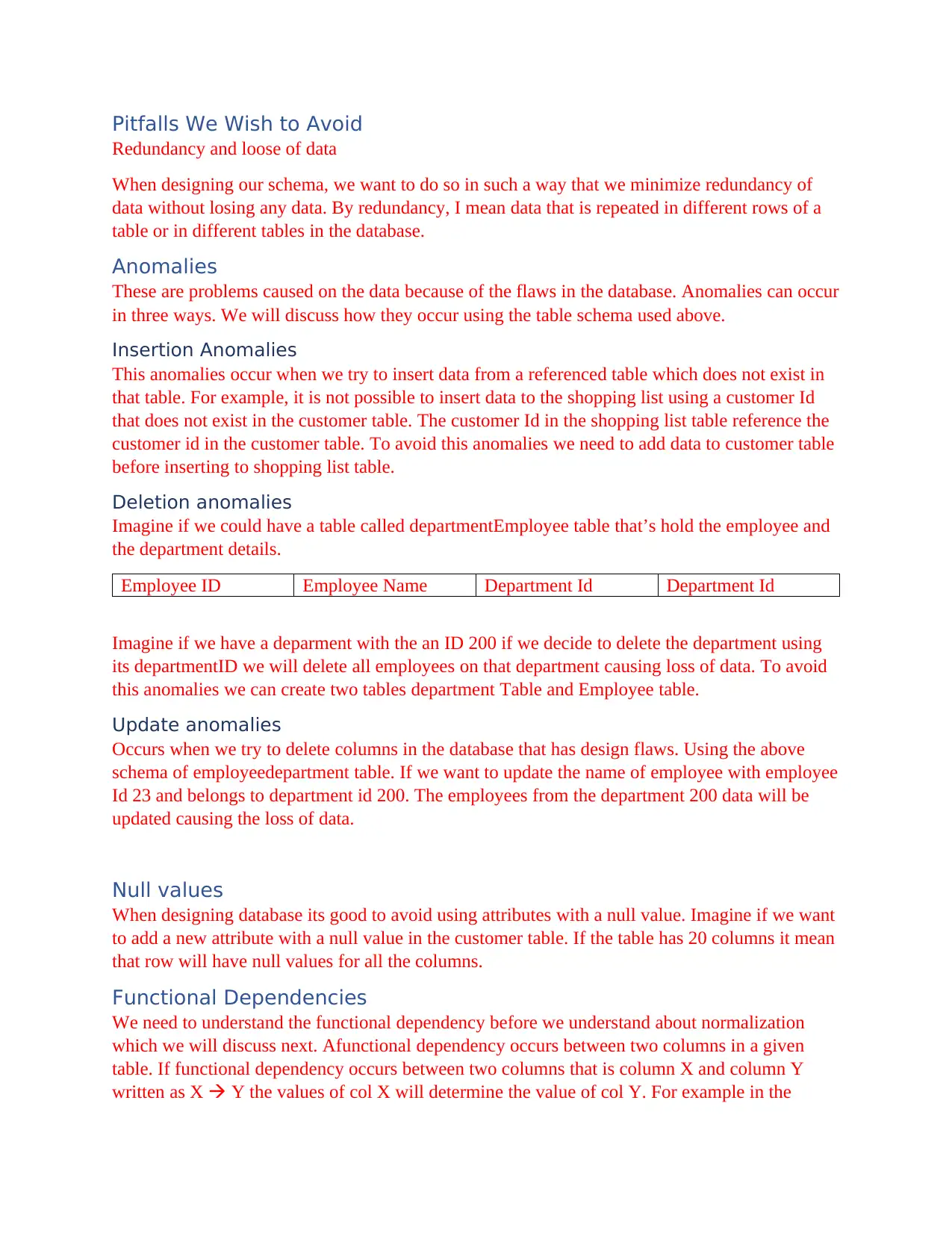
Pitfalls We Wish to Avoid
Redundancy and loose of data
When designing our schema, we want to do so in such a way that we minimize redundancy of
data without losing any data. By redundancy, I mean data that is repeated in different rows of a
table or in different tables in the database.
Anomalies
These are problems caused on the data because of the flaws in the database. Anomalies can occur
in three ways. We will discuss how they occur using the table schema used above.
Insertion Anomalies
This anomalies occur when we try to insert data from a referenced table which does not exist in
that table. For example, it is not possible to insert data to the shopping list using a customer Id
that does not exist in the customer table. The customer Id in the shopping list table reference the
customer id in the customer table. To avoid this anomalies we need to add data to customer table
before inserting to shopping list table.
Deletion anomalies
Imagine if we could have a table called departmentEmployee table that’s hold the employee and
the department details.
Employee ID Employee Name Department Id Department Id
Imagine if we have a deparment with the an ID 200 if we decide to delete the department using
its departmentID we will delete all employees on that department causing loss of data. To avoid
this anomalies we can create two tables department Table and Employee table.
Update anomalies
Occurs when we try to delete columns in the database that has design flaws. Using the above
schema of employeedepartment table. If we want to update the name of employee with employee
Id 23 and belongs to department id 200. The employees from the department 200 data will be
updated causing the loss of data.
Null values
When designing database its good to avoid using attributes with a null value. Imagine if we want
to add a new attribute with a null value in the customer table. If the table has 20 columns it mean
that row will have null values for all the columns.
Functional Dependencies
We need to understand the functional dependency before we understand about normalization
which we will discuss next. Afunctional dependency occurs between two columns in a given
table. If functional dependency occurs between two columns that is column X and column Y
written as X Y the values of col X will determine the value of col Y. For example in the
Redundancy and loose of data
When designing our schema, we want to do so in such a way that we minimize redundancy of
data without losing any data. By redundancy, I mean data that is repeated in different rows of a
table or in different tables in the database.
Anomalies
These are problems caused on the data because of the flaws in the database. Anomalies can occur
in three ways. We will discuss how they occur using the table schema used above.
Insertion Anomalies
This anomalies occur when we try to insert data from a referenced table which does not exist in
that table. For example, it is not possible to insert data to the shopping list using a customer Id
that does not exist in the customer table. The customer Id in the shopping list table reference the
customer id in the customer table. To avoid this anomalies we need to add data to customer table
before inserting to shopping list table.
Deletion anomalies
Imagine if we could have a table called departmentEmployee table that’s hold the employee and
the department details.
Employee ID Employee Name Department Id Department Id
Imagine if we have a deparment with the an ID 200 if we decide to delete the department using
its departmentID we will delete all employees on that department causing loss of data. To avoid
this anomalies we can create two tables department Table and Employee table.
Update anomalies
Occurs when we try to delete columns in the database that has design flaws. Using the above
schema of employeedepartment table. If we want to update the name of employee with employee
Id 23 and belongs to department id 200. The employees from the department 200 data will be
updated causing the loss of data.
Null values
When designing database its good to avoid using attributes with a null value. Imagine if we want
to add a new attribute with a null value in the customer table. If the table has 20 columns it mean
that row will have null values for all the columns.
Functional Dependencies
We need to understand the functional dependency before we understand about normalization
which we will discuss next. Afunctional dependency occurs between two columns in a given
table. If functional dependency occurs between two columns that is column X and column Y
written as X Y the values of col X will determine the value of col Y. For example in the
⊘ This is a preview!⊘
Do you want full access?
Subscribe today to unlock all pages.

Trusted by 1+ million students worldwide
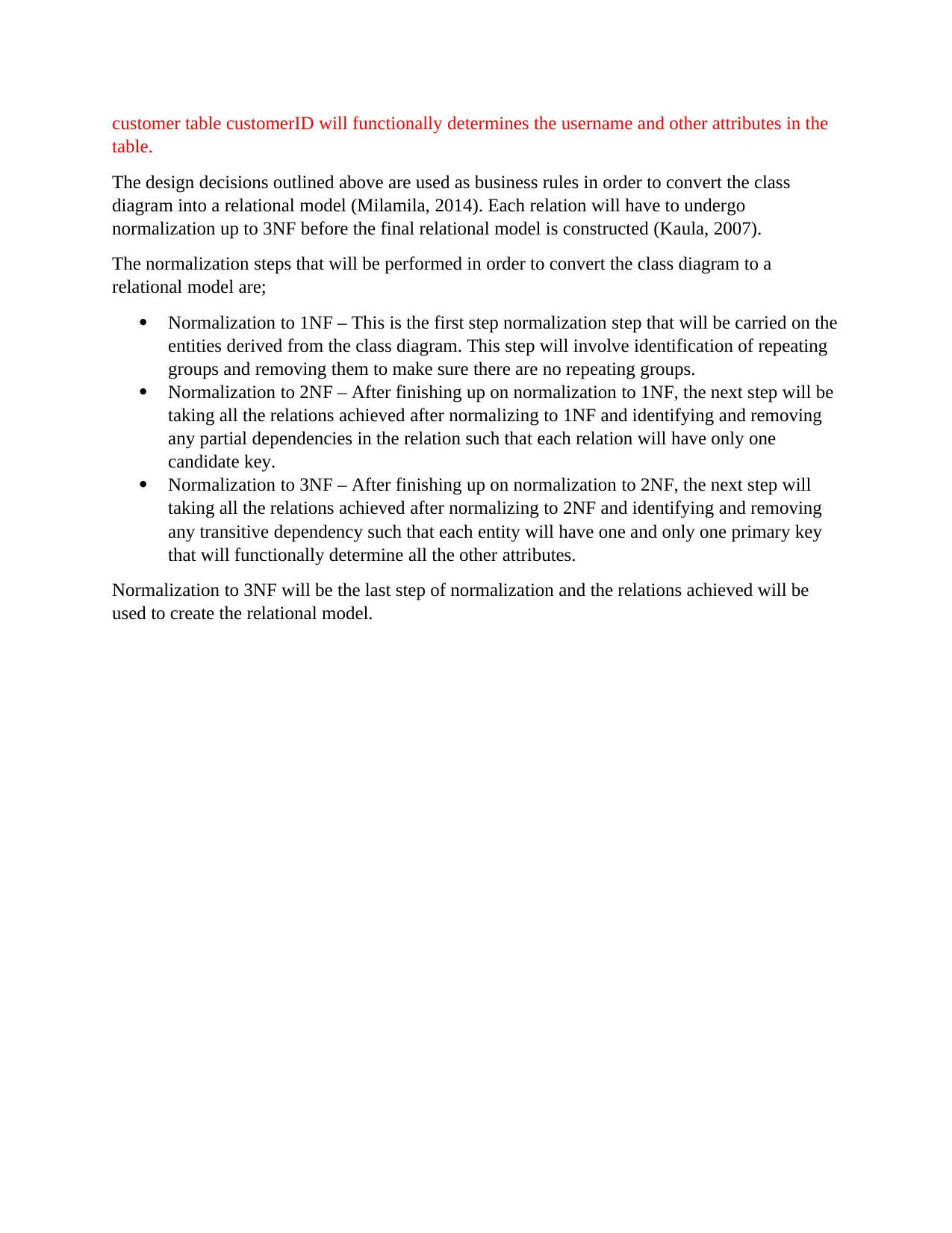
customer table customerID will functionally determines the username and other attributes in the
table.
The design decisions outlined above are used as business rules in order to convert the class
diagram into a relational model (Milamila, 2014). Each relation will have to undergo
normalization up to 3NF before the final relational model is constructed (Kaula, 2007).
The normalization steps that will be performed in order to convert the class diagram to a
relational model are;
Normalization to 1NF – This is the first step normalization step that will be carried on the
entities derived from the class diagram. This step will involve identification of repeating
groups and removing them to make sure there are no repeating groups.
Normalization to 2NF – After finishing up on normalization to 1NF, the next step will be
taking all the relations achieved after normalizing to 1NF and identifying and removing
any partial dependencies in the relation such that each relation will have only one
candidate key.
Normalization to 3NF – After finishing up on normalization to 2NF, the next step will
taking all the relations achieved after normalizing to 2NF and identifying and removing
any transitive dependency such that each entity will have one and only one primary key
that will functionally determine all the other attributes.
Normalization to 3NF will be the last step of normalization and the relations achieved will be
used to create the relational model.
table.
The design decisions outlined above are used as business rules in order to convert the class
diagram into a relational model (Milamila, 2014). Each relation will have to undergo
normalization up to 3NF before the final relational model is constructed (Kaula, 2007).
The normalization steps that will be performed in order to convert the class diagram to a
relational model are;
Normalization to 1NF – This is the first step normalization step that will be carried on the
entities derived from the class diagram. This step will involve identification of repeating
groups and removing them to make sure there are no repeating groups.
Normalization to 2NF – After finishing up on normalization to 1NF, the next step will be
taking all the relations achieved after normalizing to 1NF and identifying and removing
any partial dependencies in the relation such that each relation will have only one
candidate key.
Normalization to 3NF – After finishing up on normalization to 2NF, the next step will
taking all the relations achieved after normalizing to 2NF and identifying and removing
any transitive dependency such that each entity will have one and only one primary key
that will functionally determine all the other attributes.
Normalization to 3NF will be the last step of normalization and the relations achieved will be
used to create the relational model.
Paraphrase This Document
Need a fresh take? Get an instant paraphrase of this document with our AI Paraphraser
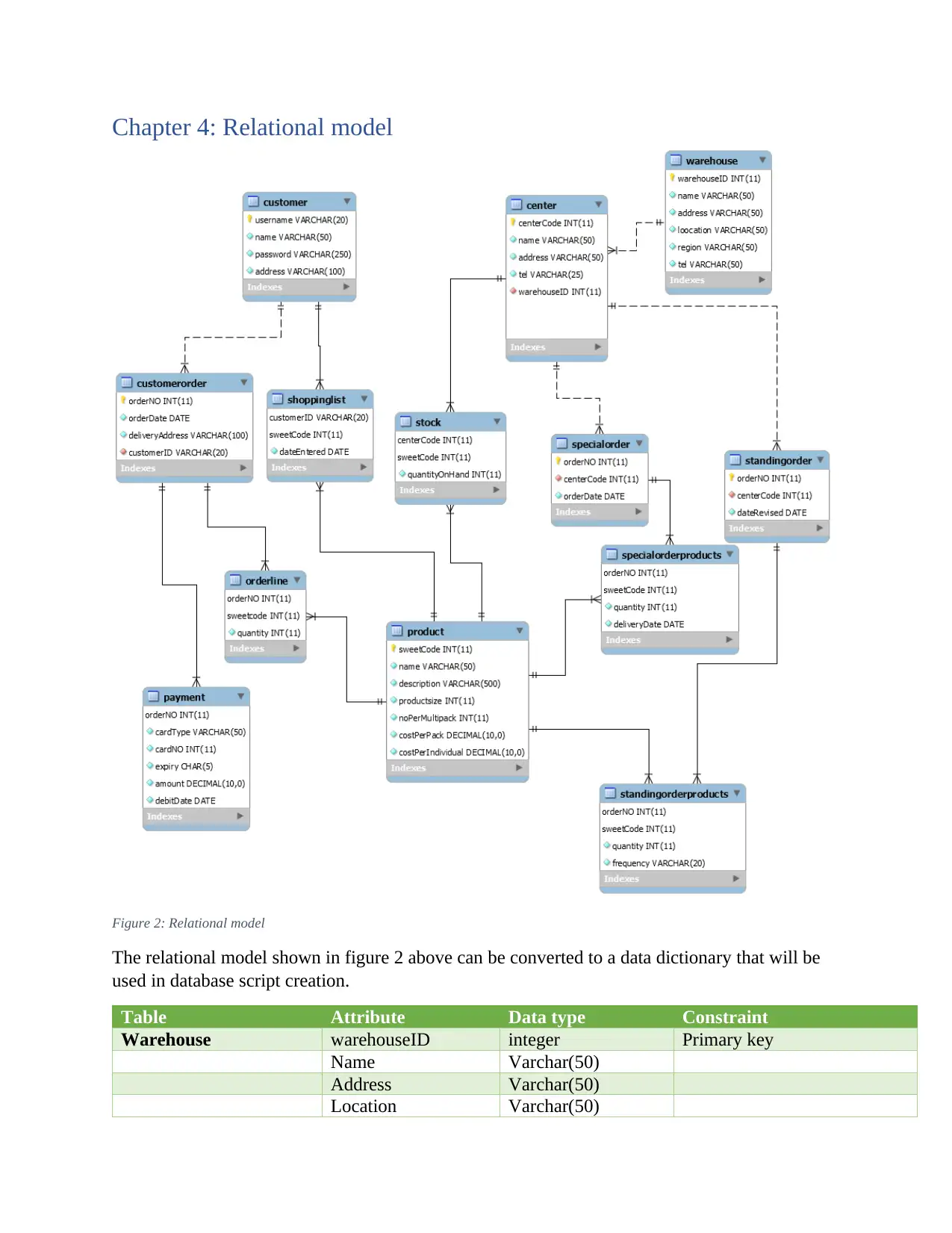
Chapter 4: Relational model
Figure 2: Relational model
The relational model shown in figure 2 above can be converted to a data dictionary that will be
used in database script creation.
Table Attribute Data type Constraint
Warehouse warehouseID integer Primary key
Name Varchar(50)
Address Varchar(50)
Location Varchar(50)
Figure 2: Relational model
The relational model shown in figure 2 above can be converted to a data dictionary that will be
used in database script creation.
Table Attribute Data type Constraint
Warehouse warehouseID integer Primary key
Name Varchar(50)
Address Varchar(50)
Location Varchar(50)
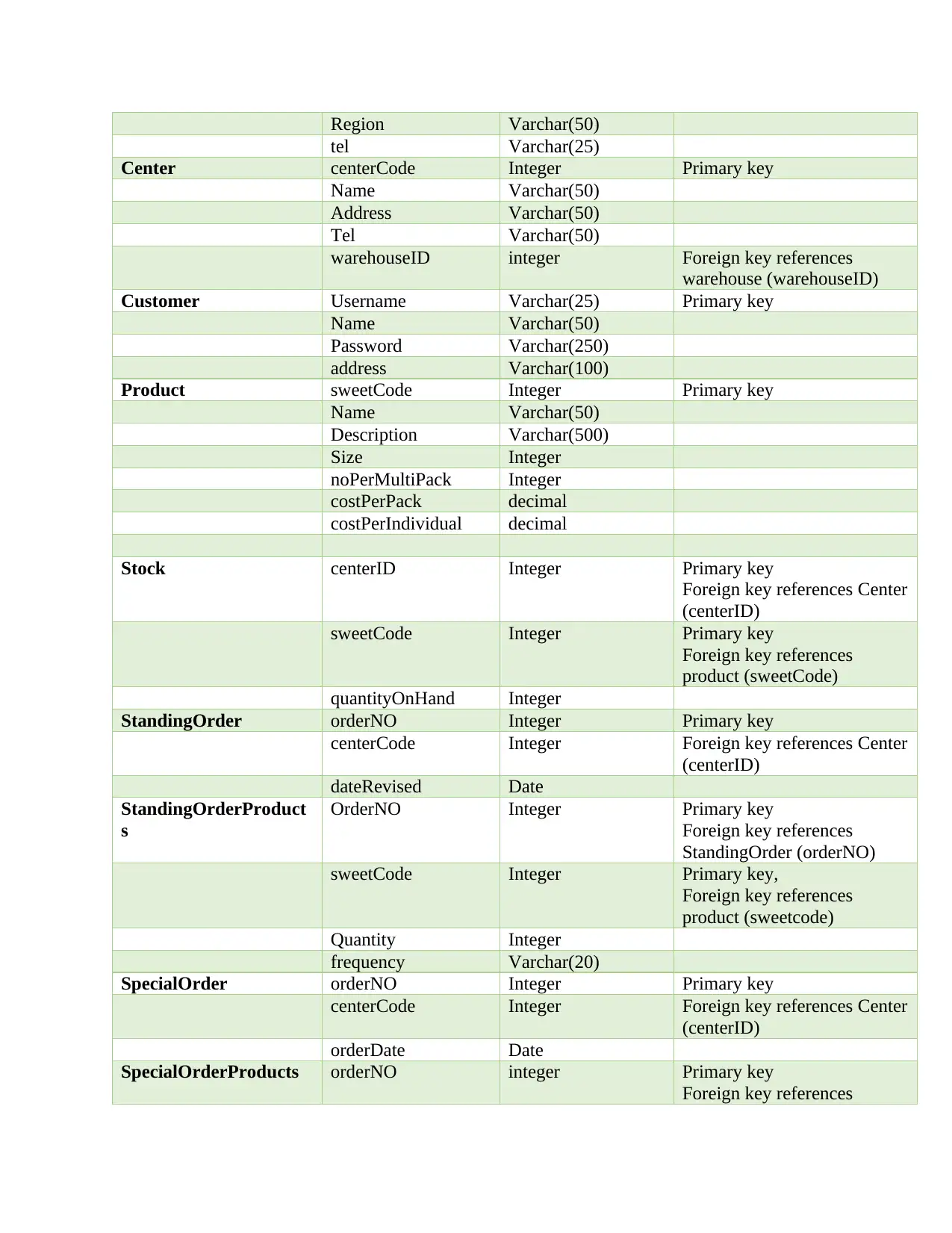
Region Varchar(50)
tel Varchar(25)
Center centerCode Integer Primary key
Name Varchar(50)
Address Varchar(50)
Tel Varchar(50)
warehouseID integer Foreign key references
warehouse (warehouseID)
Customer Username Varchar(25) Primary key
Name Varchar(50)
Password Varchar(250)
address Varchar(100)
Product sweetCode Integer Primary key
Name Varchar(50)
Description Varchar(500)
Size Integer
noPerMultiPack Integer
costPerPack decimal
costPerIndividual decimal
Stock centerID Integer Primary key
Foreign key references Center
(centerID)
sweetCode Integer Primary key
Foreign key references
product (sweetCode)
quantityOnHand Integer
StandingOrder orderNO Integer Primary key
centerCode Integer Foreign key references Center
(centerID)
dateRevised Date
StandingOrderProduct
s
OrderNO Integer Primary key
Foreign key references
StandingOrder (orderNO)
sweetCode Integer Primary key,
Foreign key references
product (sweetcode)
Quantity Integer
frequency Varchar(20)
SpecialOrder orderNO Integer Primary key
centerCode Integer Foreign key references Center
(centerID)
orderDate Date
SpecialOrderProducts orderNO integer Primary key
Foreign key references
tel Varchar(25)
Center centerCode Integer Primary key
Name Varchar(50)
Address Varchar(50)
Tel Varchar(50)
warehouseID integer Foreign key references
warehouse (warehouseID)
Customer Username Varchar(25) Primary key
Name Varchar(50)
Password Varchar(250)
address Varchar(100)
Product sweetCode Integer Primary key
Name Varchar(50)
Description Varchar(500)
Size Integer
noPerMultiPack Integer
costPerPack decimal
costPerIndividual decimal
Stock centerID Integer Primary key
Foreign key references Center
(centerID)
sweetCode Integer Primary key
Foreign key references
product (sweetCode)
quantityOnHand Integer
StandingOrder orderNO Integer Primary key
centerCode Integer Foreign key references Center
(centerID)
dateRevised Date
StandingOrderProduct
s
OrderNO Integer Primary key
Foreign key references
StandingOrder (orderNO)
sweetCode Integer Primary key,
Foreign key references
product (sweetcode)
Quantity Integer
frequency Varchar(20)
SpecialOrder orderNO Integer Primary key
centerCode Integer Foreign key references Center
(centerID)
orderDate Date
SpecialOrderProducts orderNO integer Primary key
Foreign key references
⊘ This is a preview!⊘
Do you want full access?
Subscribe today to unlock all pages.

Trusted by 1+ million students worldwide
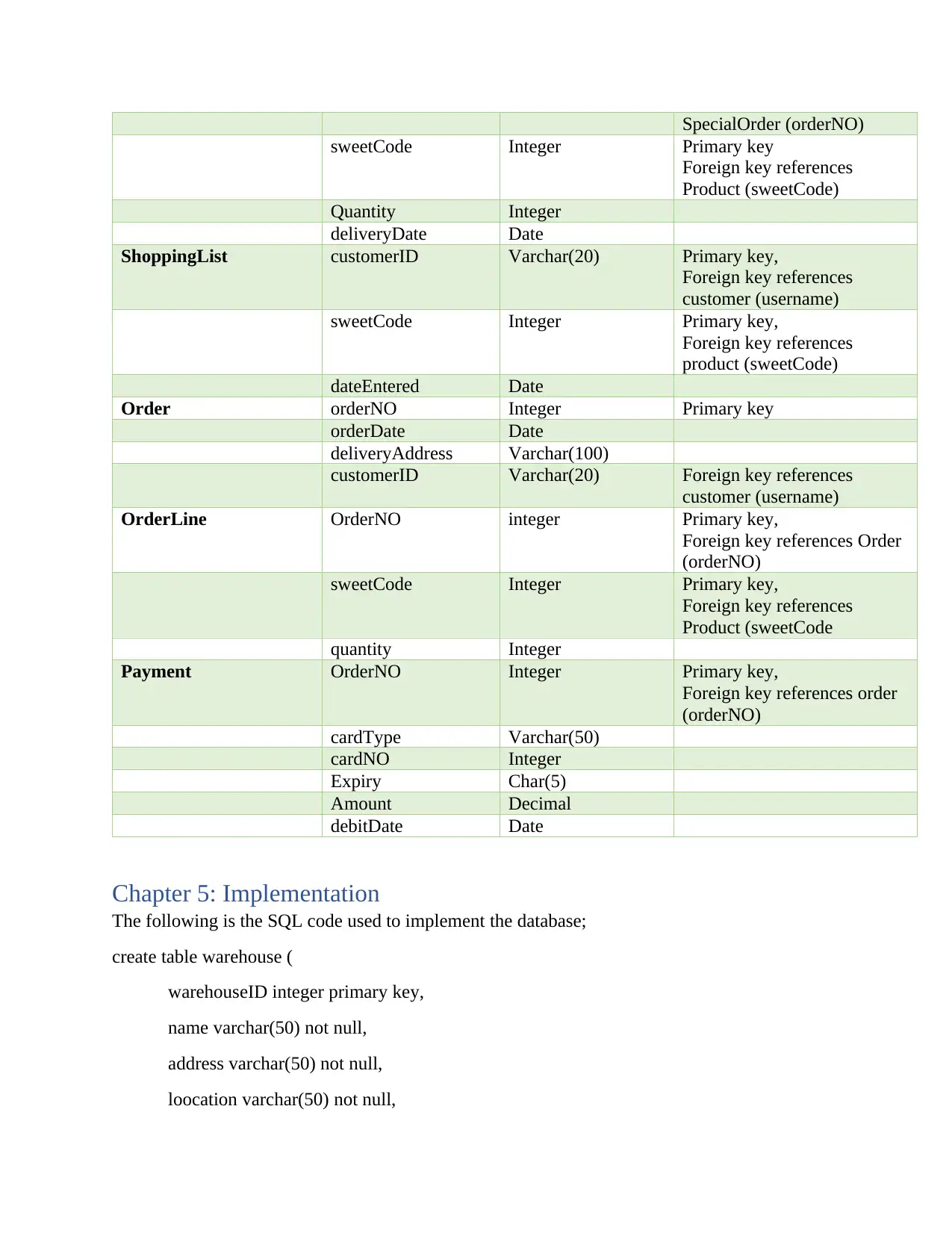
SpecialOrder (orderNO)
sweetCode Integer Primary key
Foreign key references
Product (sweetCode)
Quantity Integer
deliveryDate Date
ShoppingList customerID Varchar(20) Primary key,
Foreign key references
customer (username)
sweetCode Integer Primary key,
Foreign key references
product (sweetCode)
dateEntered Date
Order orderNO Integer Primary key
orderDate Date
deliveryAddress Varchar(100)
customerID Varchar(20) Foreign key references
customer (username)
OrderLine OrderNO integer Primary key,
Foreign key references Order
(orderNO)
sweetCode Integer Primary key,
Foreign key references
Product (sweetCode
quantity Integer
Payment OrderNO Integer Primary key,
Foreign key references order
(orderNO)
cardType Varchar(50)
cardNO Integer
Expiry Char(5)
Amount Decimal
debitDate Date
Chapter 5: Implementation
The following is the SQL code used to implement the database;
create table warehouse (
warehouseID integer primary key,
name varchar(50) not null,
address varchar(50) not null,
loocation varchar(50) not null,
sweetCode Integer Primary key
Foreign key references
Product (sweetCode)
Quantity Integer
deliveryDate Date
ShoppingList customerID Varchar(20) Primary key,
Foreign key references
customer (username)
sweetCode Integer Primary key,
Foreign key references
product (sweetCode)
dateEntered Date
Order orderNO Integer Primary key
orderDate Date
deliveryAddress Varchar(100)
customerID Varchar(20) Foreign key references
customer (username)
OrderLine OrderNO integer Primary key,
Foreign key references Order
(orderNO)
sweetCode Integer Primary key,
Foreign key references
Product (sweetCode
quantity Integer
Payment OrderNO Integer Primary key,
Foreign key references order
(orderNO)
cardType Varchar(50)
cardNO Integer
Expiry Char(5)
Amount Decimal
debitDate Date
Chapter 5: Implementation
The following is the SQL code used to implement the database;
create table warehouse (
warehouseID integer primary key,
name varchar(50) not null,
address varchar(50) not null,
loocation varchar(50) not null,
Paraphrase This Document
Need a fresh take? Get an instant paraphrase of this document with our AI Paraphraser

region varchar(50) not null,
tel varchar(50) not null
);
create table center (
centerCode integer primary key,
name varchar(50) not null,
address varchar(50) not null,
tel varchar(25) not null,
warehouseID integer not null,
foreign key (warehouseID) references warehouse (warehouseID)
);
create table customer (
username varchar(20) primary key,
name varchar(50) not null,
password varchar(250) not null,
address varchar(100) not null
);
create table product (
sweetCode integer primary key,
name varchar(50) not null,
description varchar(500) not null,
productsize integer not null,
noPerMultipack integer not null,
costPerPack decimal not null,
costPerIndividual decimal not null
tel varchar(50) not null
);
create table center (
centerCode integer primary key,
name varchar(50) not null,
address varchar(50) not null,
tel varchar(25) not null,
warehouseID integer not null,
foreign key (warehouseID) references warehouse (warehouseID)
);
create table customer (
username varchar(20) primary key,
name varchar(50) not null,
password varchar(250) not null,
address varchar(100) not null
);
create table product (
sweetCode integer primary key,
name varchar(50) not null,
description varchar(500) not null,
productsize integer not null,
noPerMultipack integer not null,
costPerPack decimal not null,
costPerIndividual decimal not null

);
create table stock (
centerCode integer not null,
sweetCode integer not null,
quantityOnHand integer not null,
primary key (centerCode,sweetCode),
foreign key (centerCode) references center (centerCode),
foreign key (sweetCode) references product (sweetCode)
);
create table standingOrder (
orderNO integer primary key,
centerCode integer not null,
dateRevised date not null,
foreign key (centerCode) references center (centerCode)
);
create table standingOrderProducts (
orderNO integer not null,
sweetCode integer not null,
quantity integer not null,
frequency varchar(20) not null,
primary key (orderNO,sweetCode),
foreign key (orderNO) references standingOrder (orderNO),
foreign key (sweetCode) references product (sweetCode)
);
Create table specialOrder (
create table stock (
centerCode integer not null,
sweetCode integer not null,
quantityOnHand integer not null,
primary key (centerCode,sweetCode),
foreign key (centerCode) references center (centerCode),
foreign key (sweetCode) references product (sweetCode)
);
create table standingOrder (
orderNO integer primary key,
centerCode integer not null,
dateRevised date not null,
foreign key (centerCode) references center (centerCode)
);
create table standingOrderProducts (
orderNO integer not null,
sweetCode integer not null,
quantity integer not null,
frequency varchar(20) not null,
primary key (orderNO,sweetCode),
foreign key (orderNO) references standingOrder (orderNO),
foreign key (sweetCode) references product (sweetCode)
);
Create table specialOrder (
⊘ This is a preview!⊘
Do you want full access?
Subscribe today to unlock all pages.

Trusted by 1+ million students worldwide
1 out of 22
Related Documents
Your All-in-One AI-Powered Toolkit for Academic Success.
+13062052269
info@desklib.com
Available 24*7 on WhatsApp / Email
![[object Object]](/_next/static/media/star-bottom.7253800d.svg)
Unlock your academic potential
Copyright © 2020–2025 A2Z Services. All Rights Reserved. Developed and managed by ZUCOL.





